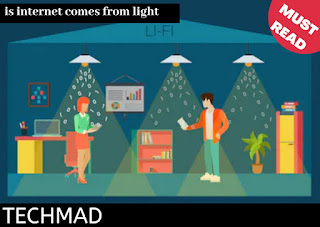#ITT
Li-Fi is one of the latest communication technologies and can be used for dual purposes to light up the house and transfer data (communicate with devices).
In an average human eye, it can intercept a frame rate of approximately 150 frames per second (and up to a maximum of 1000 fps or Hz), and so you may notice flickering light disturbance equal to or less than 150 frames per second (150 Hz). So if we can make the lights blink at higher speeds, then humans would see it as if it were constantly lit (as we see the bulbs in our homes, which also blink at around 50-60 Hz).
Operating principle:
The LEDs generate light by blinking at a very high speed according to the input data signals. And, photodetectors quickly convert that fluctuating light into a fluctuating electrical signal that represents the received data. This fluctuation of light is so rapid that the human eye cannot see it.
It is said to have achieved a maximum data transfer rate of 224 Gbps (Internet LiFi advance: 224 Gbps connection transmitted with an LED bulb).
It comes with some downsides too:
Li-Fi technology transmits data at a very high speed and is capable of delivering 224GB of data per second. Furthermore, it offers better security as compared to Wi-Fi. Due to its high speed, Li-Fi technology can be widely used in electromagnetic sensitive areas, such as hospitals, airplanes, and nuclear power plants. Innovation and new product launches are further boosting the growth of the market.
Similar to WiFi (Wireless Fidelity), LiFi stands for Light Fidelity. Fidelity, by definition, means the degree of accuracy with which something is copied or reproduced. What in this context refers to the accuracy with which the data that has been transferred could be reproduced.In an average human eye, it can intercept a frame rate of approximately 150 frames per second (and up to a maximum of 1000 fps or Hz), and so you may notice flickering light disturbance equal to or less than 150 frames per second (150 Hz). So if we can make the lights blink at higher speeds, then humans would see it as if it were constantly lit (as we see the bulbs in our homes, which also blink at around 50-60 Hz).
Operating principle:
The LEDs generate light by blinking at a very high speed according to the input data signals. And, photodetectors quickly convert that fluctuating light into a fluctuating electrical signal that represents the received data. This fluctuation of light is so rapid that the human eye cannot see it.
It is said to have achieved a maximum data transfer rate of 224 Gbps (Internet LiFi advance: 224 Gbps connection transmitted with an LED bulb).
It comes with some downsides too:
- Any slight obstruction can stop communication.
- Any external light source can cause interference.
- The speed and quality of the data depend on the distance from the source.
- We cannot use data after turning off the lights.
An article by Munna Suprathik









0 Comments
Post a Comment
Hi guys feel free to ask any questions 0r suggestions